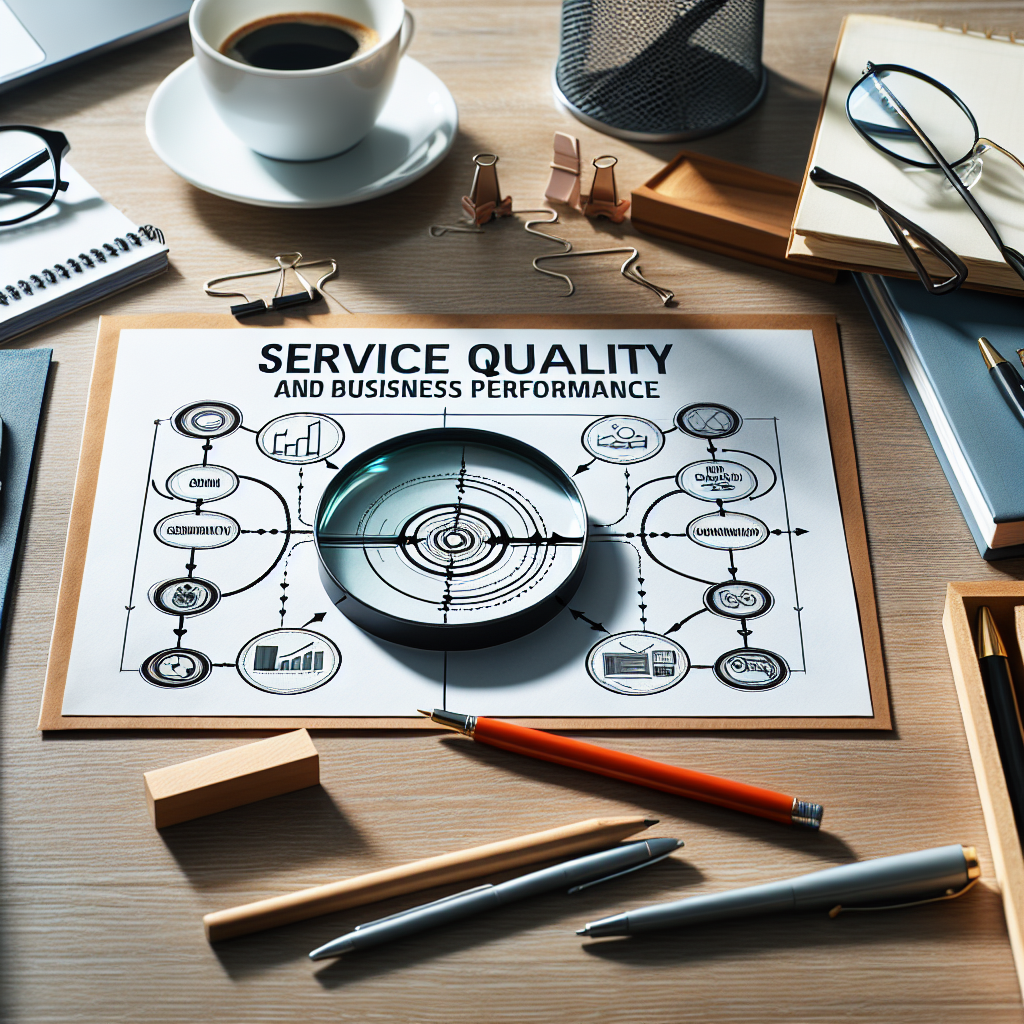Service quality plays a crucial role in determining the success or failure of businesses in today’s competitive market. The way a company delivers its services directly impacts customer satisfaction, which in turn influences business performance. From customer loyalty and retention rates to profitability and market share, the connection between service quality and business performance is undeniable. Velocity is critical since many companies rely heavily upon high speed internet to deliver experiences. In this article, we will delve into the intricate relationship between the two, exploring how businesses can leverage high service quality to drive overall success. Join us on this enlightening journey as we unveil the powerful connection between service excellence and sustainable business growth.
The Fundamentals of Service Quality and Business Performance

In the realm of business, service quality plays a pivotal role in determining the success and longevity of an organization. The essence of service quality lies in the ability of a company to meet or exceed customer expectations consistently. It encompasses various aspects that collectively contribute to the overall customer experience and satisfaction levels.
Defining service quality in the context of business
Service quality can be defined as the degree to which a company’s products or services meet or exceed customer expectations. It goes beyond just the tangible features of a product or service and delves into the intangible aspects such as customer service, responsiveness, reliability, and empathy. In essence, service quality reflects the overall customer perception of the value received in exchange for their patronage.
Understanding the various dimensions of service quality
Service quality comprises multiple dimensions that collectively shape the customer experience. These dimensions often include:
– Reliability: The ability of a company to deliver its products or services consistently and dependably.
– Responsiveness: How promptly and effectively a company addresses customer inquiries, complaints, or service requests.
– Assurance: The competence, courtesy, credibility, and trustworthiness exhibited by the company’s employees.
– Empathy: The level of care, individualized attention, and understanding demonstrated towards customers.
– Tangibles: The physical facilities, equipment, and communication materials that convey professionalism and quality.
Exploring the significance of business performance in a competitive landscape
Business performance serves as a critical indicator of how well a company is achieving its strategic objectives and fulfilling its mission. In a competitive landscape, superior business performance can provide a company with a sustainable competitive advantage. Factors such as profitability, market share, customer retention, and operational efficiency all contribute to business performance. By focusing on enhancing service quality, companies can positively influence their business performance metrics, leading to increased customer loyalty, market differentiation, and ultimately, financial success.
Key Components of Service Quality
The Fundamentals of Service Quality and Business Performance
- Reliability
- Reliability is the cornerstone of service quality and refers to the ability of a business to deliver services consistently and accurately.
- Customers value reliability as it builds trust and confidence in the business’s ability to meet their needs.
- Consistent service delivery leads to customer satisfaction and loyalty, ultimately impacting business performance positively.
- Responsiveness
- Responsiveness is the promptness and willingness of a business to address customer inquiries, issues, or requests.
- Businesses that prioritize responsiveness demonstrate a customer-centric approach, enhancing the overall service experience.
- Quick responses to customer needs can lead to increased customer satisfaction, repeat business, and referrals, which are vital for business growth.
- Assurance
- Assurance pertains to the knowledge, competence, and professionalism exhibited by employees when interacting with customers.
- Customers seek assurance that they are in capable hands and that their needs will be met competently.
- Businesses that provide assurance through well-trained staff and clear communication instill confidence in customers, leading to enhanced service quality perception.
- Empathy
- Empathy involves understanding and showing compassion towards customers’ emotions, concerns, and situations.
- Businesses that demonstrate empathy create a personalized experience that resonates with customers on a deeper level.
- Empathetic interactions foster strong customer relationships, trust, and loyalty, which are pivotal for long-term business success.
- Tangibles
- Tangibles encompass the physical aspects of service delivery, including facilities, equipment, and appearance.
- The tangible elements contribute to the overall perception of service quality and reflect the professionalism and attention to detail of the business.
- Well-maintained tangibles signal quality and reliability to customers, influencing their perception of the service and impacting business performance.
The Impact of Service Quality on Business Performance
Service quality plays a crucial role in determining the success and sustainability of a business. By focusing on delivering exceptional service, organizations can reap a multitude of benefits that directly contribute to enhanced business performance. The following points highlight the significant impact of service quality on various aspects of business performance:
- Enhancing customer satisfaction and loyalty:
- Providing high-quality services leads to increased customer satisfaction, as customers are more likely to have their needs and expectations met.
- Satisfied customers are more inclined to remain loyal to a business, leading to repeat purchases and long-term relationships.
- Building a strong brand reputation:
- Consistently delivering excellent service helps in building a positive brand reputation in the market.
- A strong brand reputation not only attracts new customers but also instills trust and credibility among existing ones.
- Generating positive word-of-mouth and referrals:
- Satisfied customers are more likely to share their positive experiences with others, leading to valuable word-of-mouth referrals.
- Positive word-of-mouth marketing is a powerful tool for acquiring new customers at a low cost, as personal recommendations are highly influential.
- Increasing customer retention and lifetime value:
- Businesses that prioritize service quality are better positioned to retain their existing customer base.
- Loyal customers who are satisfied with the service provided are likely to continue patronizing the business, thus increasing their lifetime value and overall contribution to the company’s revenue.
Metrics for Measuring Service Quality
Effective measurement of service quality is crucial for businesses to understand and improve their performance. Various metrics are utilized to gauge the level of service quality provided to customers. These metrics offer insights into customer satisfaction, loyalty, and overall business success. The following are key metrics commonly used to measure service quality:
- Net Promoter Score (NPS): NPS is a metric that assesses the likelihood of customers to recommend a company’s products or services to others. It is based on a simple question: “On a scale of 0-10, how likely are you to recommend us to a friend or colleague?” Customers are categorized as Promoters (score 9-10), Passives (score 7-8), or Detractors (score 0-6). The NPS is calculated by subtracting the percentage of Detractors from the percentage of Promoters, resulting in a score that indicates overall customer loyalty and satisfaction.
- Customer Satisfaction Score (CSAT): CSAT measures the level of satisfaction customers have with a specific interaction, product, or service. It is typically based on a survey question asking customers to rate their satisfaction on a scale (e.g., 1-5 or 1-10). The aggregated scores provide insights into the overall satisfaction levels of customers, helping businesses identify areas for improvement and monitor performance over time.
- Customer Effort Score (CES): CES focuses on the ease with which customers can interact with a company to resolve issues or accomplish tasks. Customers are asked to rate the level of effort required to complete a specific transaction or resolve a problem. Lower effort scores indicate a more seamless customer experience, while higher scores may signify potential pain points that need to be addressed to enhance service quality.
- Service Level Agreements (SLAs): SLAs are formal agreements that outline the level of service a customer can expect from a provider. These agreements establish measurable performance targets related to response times, resolution times, uptime, and other service-related metrics. By tracking adherence to SLAs, businesses can evaluate their service quality against defined standards and ensure consistency in delivering services that meet customer expectations.

Strategies for Improving Service Quality
In today’s competitive business landscape, organizations must prioritize service quality to enhance their overall business performance. Implementing effective strategies to improve service quality can significantly impact customer satisfaction, loyalty, and ultimately, business success. Here are some key strategies that businesses can adopt to enhance their service quality:
Employee training and development programs
Investing in comprehensive training and development programs for employees is crucial for ensuring high service quality standards. By equipping staff with the necessary skills, knowledge, and tools, organizations can enhance their ability to deliver exceptional service experiences to customers. Training should focus on customer service best practices, effective communication techniques, problem-solving skills, and product knowledge. Continuous training and development initiatives can empower employees to handle customer inquiries efficiently, resolve issues promptly, and exceed customer expectations.
Implementing technology for better service delivery
Incorporating innovative technologies can streamline service delivery processes and enhance overall customer experience. Automation tools, customer relationship management (CRM) systems, and self-service portals can help businesses deliver faster, more personalized services to customers. Implementing chatbots for instant customer support, utilizing data analytics for personalized recommendations, and offering online booking platforms are examples of how technology can be leveraged to improve service quality. By embracing digital solutions, organizations can optimize operational efficiency, reduce response times, and deliver seamless customer interactions across various touchpoints.
Collecting and analyzing customer feedback for continuous improvement
Gathering and analyzing customer feedback is essential for understanding customer preferences, identifying areas for improvement, and enhancing service quality. Implementing customer feedback mechanisms such as surveys, reviews, and Net Promoter Score (NPS) assessments can provide valuable insights into customer perceptions and satisfaction levels. Analyzing feedback data allows businesses to pinpoint pain points, address customer concerns, and make informed decisions to enhance service quality. By actively seeking and acting upon customer feedback, organizations demonstrate their commitment to continuous improvement and customer-centricity.
Creating a customer-centric culture within the organization
Fostering a customer-centric culture is fundamental to delivering exceptional service quality and driving business performance. Organizations that prioritize customer needs, preferences, and satisfaction create a customer-centric mindset among employees at all levels. By instilling a customer-focused ethos, businesses can empower employees to prioritize customer satisfaction, anticipate customer needs, and deliver personalized service experiences. Encouraging customer-facing teams to go above and beyond to exceed customer expectations, rewarding customer-centric behaviors, and aligning organizational goals with customer success can help cultivate a culture that values service excellence and customer loyalty.
Case Studies: Successful Implementation of Service Quality Strategies
- Company A: Implementing a customer feedback loop to drive service improvements
In Company A, the implementation of a customer feedback loop has been integral to enhancing service quality and, consequently, business performance. By actively seeking and listening to customer feedback, the company has been able to pinpoint areas for improvement and address them promptly. Through the feedback loop, Company A has gained valuable insights into customer preferences, pain points, and expectations, allowing them to tailor their services to better meet customer needs. This customer-centric approach has not only led to increased customer satisfaction but has also translated into improved business performance metrics such as customer retention and profitability.
- Company B: Investing in employee empowerment to enhance service delivery

Company B’s focus on employee empowerment as a service quality strategy has yielded significant results in terms of business performance. By investing in training, development, and empowerment initiatives, the company has equipped its employees with the tools and autonomy to deliver exceptional service experiences to customers. This empowerment has not only boosted employee morale and engagement but has also translated into tangible outcomes such as higher service quality standards, increased efficiency, and a more personalized customer experience. As a result, Company B has seen a positive impact on key performance indicators such as customer loyalty, brand reputation, and overall business growth.
Maximizing Business Performance through Service Quality
In today’s competitive business landscape, the quality of services offered plays a crucial role in determining the overall performance and success of a company. Maximizing business performance through service quality involves a strategic approach that aligns service delivery with the organization’s overarching objectives.
Aligning service quality goals with overall business objectives
- Strategic Integration: It is imperative for organizations to align their service quality goals with the broader business objectives to ensure a cohesive approach towards achieving success.
- Consistent Focus: By integrating service quality goals with business objectives, companies can ensure that all efforts are directed towards enhancing customer satisfaction and loyalty, ultimately driving business performance.
- Measurable Outcomes: Establishing clear metrics and KPIs that link service quality improvements to key business performance indicators enables organizations to track progress and make informed decisions.
Leveraging service quality as a competitive advantage
- Differentiation Strategy: By consistently delivering high-quality services, companies can differentiate themselves from competitors and create a unique selling proposition in the market.
- Customer Retention: High service quality leads to increased customer satisfaction and loyalty, reducing churn rates and fostering long-term relationships with clients.
- Brand Reputation: A reputation for superior service quality can enhance brand image and credibility, attracting new customers and strengthening market positioning.
Continuously monitoring and adjusting service quality strategies for optimal results
- Performance Evaluation: Regularly monitoring service quality metrics and soliciting feedback from customers allows organizations to identify areas for improvement and make necessary adjustments.
- Continuous Improvement: Adopting a culture of continuous improvement ensures that service quality standards are constantly being raised to meet or exceed customer expectations.
- Agility in Response: Being responsive to feedback and market changes enables businesses to adapt their service quality strategies in real-time, optimizing performance and maintaining a competitive edge.
FAQs: Service Quality and Business Performance: Unveiling the Connection
What is the relationship between service quality and business performance?
Service quality has a direct impact on business performance. Providing high-quality services can lead to increased customer satisfaction, loyalty, and retention, which in turn can boost sales and revenue. When customers have positive experiences with a company’s services, they are more likely to recommend it to others and become repeat customers, ultimately contributing to the overall success of the business.
How can businesses measure service quality?
Businesses can measure service quality through various methods such as customer surveys, feedback forms, mystery shopping, and online reviews. These tools help businesses gather valuable insights into customer perceptions of their services and identify areas for improvement. By regularly monitoring and evaluating service quality, businesses can proactively address any issues and enhance the overall customer experience.
What are the benefits of maintaining high service quality?
Maintaining high service quality can result in numerous benefits for businesses, including increased customer satisfaction, loyalty, and retention. Satisfied customers are more likely to make repeat purchases and recommend the business to others, driving revenue and profitability. Additionally, high service quality can help businesses differentiate themselves from competitors and establish a strong reputation in the market, attracting new customers and fostering long-term relationships.
How can businesses improve service quality?
Businesses can improve service quality by investing in employee training and development, implementing customer feedback systems, and continuously monitoring and updating service standards. By empowering employees with the necessary skills and knowledge to deliver exceptional service, businesses can create a positive and memorable customer experience. Additionally, soliciting feedback from customers and using that information to make improvements can help businesses address any shortcomings and enhance service quality over time.

